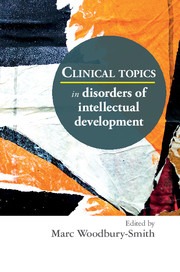Book contents
- Frontmatter
- Contents
- List of contributors
- Foreword
- Preface
- Part 1 Disorders of intellectual development: concept and epidemiology
- Part 2 Disorders of intellectual development: comorbidity and complications
- 3 Psychiatric illness and disorders of intellectual development: a dual diagnosis
- 4 Anxiety disorders
- 5 Behaviour problems
- 6 Epilepsy
- 7 The use of psychotropic medications to manage problem behaviours in adults
- Part 3 Autism spectrum disorder
- Part 4 Service provision
- Index
5 - Behaviour problems
from Part 2 - Disorders of intellectual development: comorbidity and complications
Published online by Cambridge University Press: 01 January 2018
- Frontmatter
- Contents
- List of contributors
- Foreword
- Preface
- Part 1 Disorders of intellectual development: concept and epidemiology
- Part 2 Disorders of intellectual development: comorbidity and complications
- 3 Psychiatric illness and disorders of intellectual development: a dual diagnosis
- 4 Anxiety disorders
- 5 Behaviour problems
- 6 Epilepsy
- 7 The use of psychotropic medications to manage problem behaviours in adults
- Part 3 Autism spectrum disorder
- Part 4 Service provision
- Index
Summary
Preamble
Problem or challenging behaviours are the terms most frequently used to describe the behaviours under review here. Both terms direct attention to the fact that these behaviours are particularly problematic to care providers and the public; neither, however, speaks adequately to the co-constructed nature of these behaviours, nor to the personal distress individuals engaging in these behaviours may be experiencing. People with disorders of intellectual development (PWDID) in this context are communicating their needs, desires, medical conditions and mental distress as best they can. When asked to evaluate these behaviours, it is this communication we need to analyse and understand.
In this chapter, the abbreviation PB will be used when reporting previously published literature on problem and challenging behaviours. Depending on the focus of concern, we use the terms ‘distress behaviours’ and ‘socially unacceptable behaviours’ respectively to denote more precisely behaviours individuals are engaging in because they are distressed and behaviours that are distressing to care providers and the public but not necessarily to the individual.
Introduction
Thus, ‘PB’ refers to a broad class of behaviours shown by PWDID. They include aggression to self (e.g. self-injury), to others (e.g. hitting, biting) and to the environment (e.g. destructiveness), stereotyped mannerisms and a range of other behaviours which may be either harmful to the individual (e.g. eating inedible substances), challenging for care providers (e.g. persistent screaming, disturbed sleep patterns, overactivity, noncompliance) and/or objectionable to members of the public (e.g. smearing of faeces or saliva on self and others, regurgitation of food) (Emerson & Einfeld, 2011). These behaviours prevent full integration of some PWDID into mainstream life and impoverish quality of life for them and their care providers.
Prevalence estimates of PB range widely from a ‘best estimate’ of 15–17.5% in general populations of PWDID (Koritsas & Iacono, 2012a) to 42–82% in those with profound intellectual and multiple disabilities (Poppes et al, 2010). Differences in rates are associated with: ascertainment methodology; type of PB; individual characteristics such as gender, age, severity of disability, associated impairments, other developmental and medical conditions; and living arrangement.
- Type
- Chapter
- Information
- Clinical Topics in Disorders of Intellectual Development , pp. 72 - 112Publisher: Royal College of PsychiatristsPrint publication year: 2015

